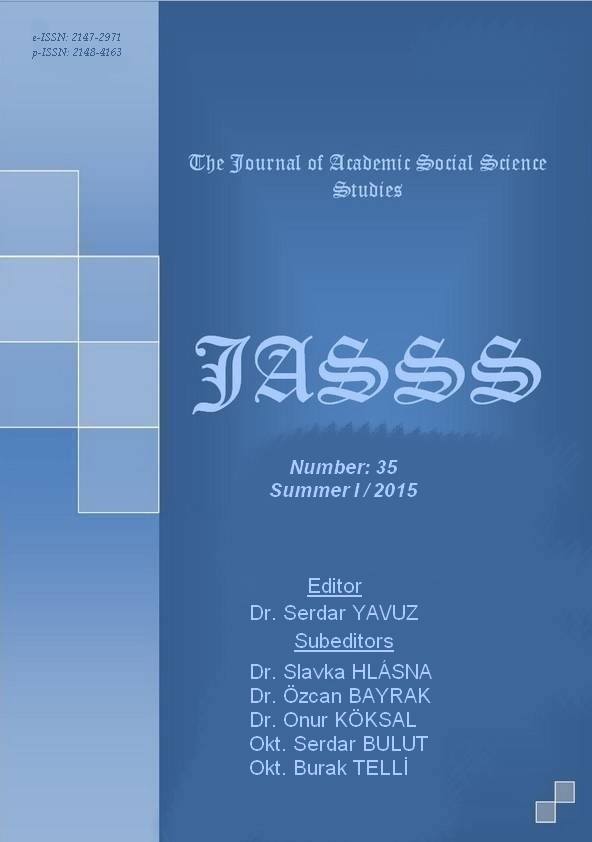Author :
Abstract
Bu çalışmanın amacı, Ganos (Işıklar) Dağı ve yakın çevresindeki drenaj sisteminin özelliklerinin ve tiplerinin açıklanmasıdır. Temel materyal olarak HGK (Harita Genel Komutanlığı) tarafından hazırlanan Türkiye Topoğrafya Haritalarının 1/25.000 ölçekli BANDIRMA G18; a3, b3, b4, c1, d2, d3 numaralı topoğrafya paftalarının kullanıldığı çalışmada, CBS (Coğrafi Bilgi Sistemleri) tekniklerinden yararlanılmıştır. Ayrıca çeşitli kaynaklardan elde edilen verilerden de istifade edilmiştir. Yöntem olarak fiziki coğrafya ilkelerinin temel prensipleri eşliğinde gerçekleştirilen hidrografik çalışmalarda kullanılan klasik metottan faydalanılmıştır. Çalışmanın veri toplama ve kontrolü arazi çalışmalarıyla sağlanmıştır. Sonuçta hidrografik açıdan hem Marmara hem de Ege denizlerine dökülen akarsular tarafından drene edilen inceleme alanındaki akarsu ağının bugünkü karakterini esas olarak Üst Pleyistosen’de kazandığı ve günümüzdeki ana drenaj şebekesinin denge profiline ulaşmaya çalıştığı anlaşılmıştır. Topoğrafyadaki parçalanma derecesi veya akarsu yoğunluğunun tekdüze olmadığı bu alanda, bazı kesimlerde düşük akarsu yoğunluğu bazı kesimlerde de yüksek akarsu yoğunluğu değerleri tespit edilmiştir. Toplam akarsu uzunluğunun 1157 km olduğu bu sahada km²’ye düşen drenaj yoğunluğunun ortalaması 2.54 km/km² olarak hesaplanmıştır. İnceleme alanındaki akarsu ağının oluşum ve gelişiminde jeoloji, topoğrafya, iklim ve bitki örtüsü belirleyici rolü oynamıştır. Böylece ilgili faktörler ve etkinlik derecelerine bağlı olarak dantritik, paralel, kancalı, radyal, kafesli ve sentripetal drenaj tipleri tanımlanmıştır. Ayrıca bu sahada etkili olan tektonik hareketler neticesinde gerçekleşen gençleşmeler bazı akarsularda ötelenmelere, gömük mendereslerin belirmesine veya kapma hadiselerinin yaşanmasına kaynak teşkil etmiştir. Flüvyal morfojenetik bölge sınırları içerisinde kaldığı için akarsu etkinliğinin yoğun olarak hissedildiği inceleme alanındaki drenaj ağı, hidrojeomorfolojik gelişim döngüsü esnasında yaşanan olaylara çok güçlü bir tepki vermiştir. Bu durum sahadaki güncel drenaj sisteminin de ortaya çıkmasında belirleyici olmuştur. Konu hakkında farklı sahalarda benzer araştırmaların yapılması yeryüzünü şekillendirici en etkili dış kuvvet olan akarsu sistemini anlamamız ve ondan en yararlı bir şekilde istifade etmemiz için önemlidir. Bu çalışmanın sonuçları sahadaki jeomorfolojik ve hidrografik gelişim sürecinin açıklanmasında ve doğal ortamdaki diğer unsurların etkilerinin çözümlenmesi
Keywords
Abstract
The aim of the present study is to describe the characteristics and the types of the drainage system in and around the Ganos (Işıklar) Mount. In this study, 1/25.000-scaled topographic map sheets numbered BANDIRMA G18 a3, b3, b4, c1, d2, and d3 of Turkey’s Topographic Maps prepared by the General Command of Mapping were used as the main materials beside GIS (Geographic Information System) techniques. Also, the data obtained from various resources were used. The classical method used in hydrographical studies carried out in line with the fundamental aspects of the physical geography principles was followed. The research data were collected and checked through field works. It was found out that the river system in the study area that was drained by the rivers flowing into both the Marmara Sea and the Aegean Sea gained its characteristics mainly from the Upper Pleistocene and that the main drainage system was on the way to reaching the equilibrium profile. In the study area where the degree of fragmentation in the topography or the density of the river was not uniform, it was determined that the density of the river was low in some parts while it was high in others. The average drainage density per km² in this area where the length of the river is 1157 km was found to be 2.54 km/km². Geology, topography, climate, and vegetation played an important role in the composition and development of the river system in the study area. Thus, dendritic, parallel, barbed, radial, lattice, and centripetal drainage patterns were identified in line with the related factors and their degree of activity. Also, the regeneration taking place as a result of the tectonic movements seen in the area was the reason for the occurrence of translations, incised meanders, or the incidents of capture. The drainage system in the study area, where the activity of the river was intensely felt as it remained inside the borders of the fluvial morphogenetic area, gave a very strong reaction to the phenomena seen during the hydro-geomorphological development cycle. This situation played a role in the formation of the current drainage system in the area. Carrying out similar works in different areas on this subject is important for understanding the river system which is the most effective external force that shapes the earth and for making the best use of it. The results of the present study can be used for explaining geomorphologic and hydrographic development processes in the area and for anal





